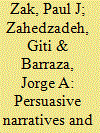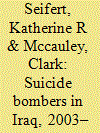| Srl | Item |
| 1 |
ID:
152867


|
|
|
|
|
| Summary/Abstract |
Persuasive narratives can induce some individuals to engage in costly actions. Entrepreneurs of suicide missions frame the necessity of violent behavior within the context of persuasive narratives to attract potential recruits. Herein we report results from an experiment to test factors involved with costly action linked to a persuasive narrative. We recruited 164 participants (M = 21, SD = 5.20) and measured hormones, electrodermal activity, and personality to predict who would be influenced by the narrative's message. We found that the persuasive narrative we tested resulted in costly action by those who are high-perspective takers and are more physiologically aroused by the narrative. The findings fill lacunae in the literature, providing a novel approach to examine costly behavior (like martyrdom missions) in the laboratory.
|
|
|
|
|
|
|
|
|
|
|
|
|
|
|
|
| 2 |
ID:
134991


|
|
|
|
|
| Summary/Abstract |
Extending data reported by Mohammed Hafez in 2007, we compiled a database of 1,779 suicide bombers who attempted or completed attacks in Iraq from 2003 through 2010. From 2003 through 2006, monthly totals of suicide bombers show a pattern different from the pattern of non-suicide insurgent attacks, but from 2007 through 2010 the two patterns were similar. This biphasic pattern indicates that suicide attacks sometimes warrant separate analysis but sometimes are just one tactic in a larger envelope of insurgent violence. We also show that only 13 percent of suicide bombers targeted coalition forces and international civilians, primarily during the early years of the conflict, whereas 83 percent of suicide bombers targeted Iraqis (civilians, members of the Anbar Awakening Movement, Iraqi security forces, and government entities) in attacks that extended throughout the duration of the insurgency. These results challenge the idea that suicide attacks are primarily a nationalist response to foreign occupation, and caution that “smart bombs” may be more often sent against soft targets than hard targets. More generally, our results indicate that suicide attacks must be disaggregated by target in order to understand these attacks as the expression of different insurgent priorities at different times.
|
|
|
|
|
|
|
|
|
|
|
|
|
|
|
|